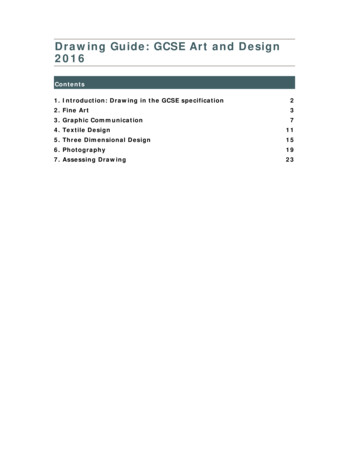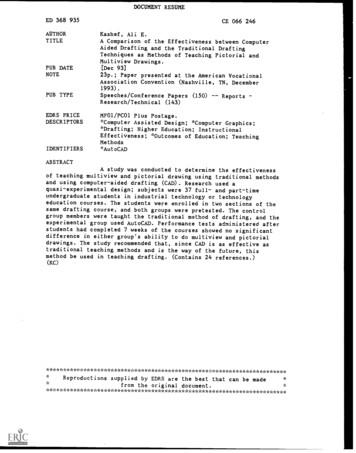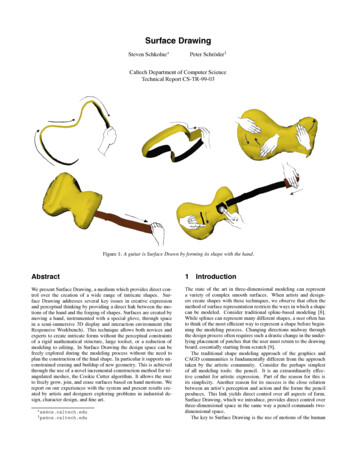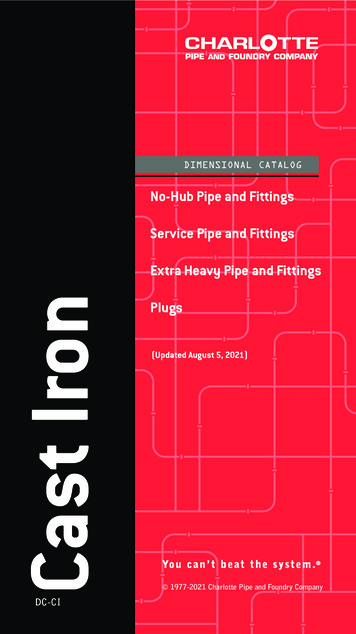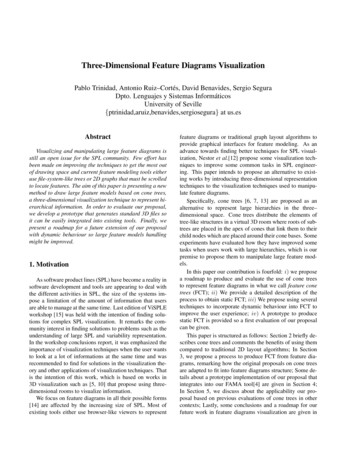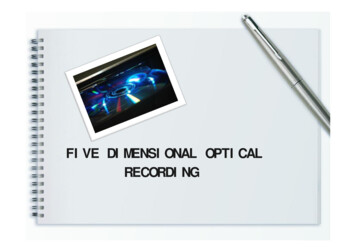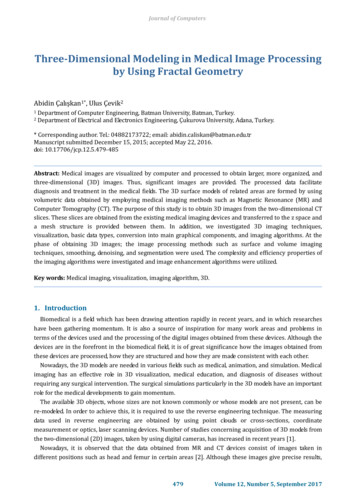
Transcription
Journal of ComputersThree-Dimensional Modeling in Medical Image Processingby Using Fractal GeometryAbidin Çalışkan1*, Ulus Çevik212Department of Computer Engineering, Batman University, Batman, Turkey.Department of Electrical and Electronics Engineering, Çukurova University, Adana, Turkey.* Corresponding author. Tel.: 04882173722; email: abidin.caliskan@batman.edu.trManuscript submitted December 15, 2015; accepted May 22, 2016.doi: 10.17706/jcp.12.5.479-485Abstract: Medical images are visualized by computer and processed to obtain larger, more organized, andthree-dimensional (3D) images. Thus, significant images are provided. The processed data facilitatediagnosis and treatment in the medical fields. The 3D surface models of related areas are formed by usingvolumetric data obtained by employing medical imaging methods such as Magnetic Resonance (MR) andComputer Tomography (CT). The purpose of this study is to obtain 3D images from the two-dimensional CTslices. These slices are obtained from the existing medical imaging devices and transferred to the z space anda mesh structure is provided between them. In addition, we investigated 3D imaging techniques,visualization, basic data types, conversion into main graphical components, and imaging algorithms. At thephase of obtaining 3D images; the image processing methods such as surface and volume imagingtechniques, smoothing, denoising, and segmentation were used. The complexity and efficiency properties ofthe imaging algorithms were investigated and image enhancement algorithms were utilized.Key words: Medical imaging, visualization, imaging algorithm, 3D.1. IntroductionBiomedical is a field which has been drawing attention rapidly in recent years, and in which researcheshave been gathering momentum. It is also a source of inspiration for many work areas and problems interms of the devices used and the processing of the digital images obtained from these devices. Although thedevices are in the forefront in the biomedical field, it is of great significance how the images obtained fromthese devices are processed, how they are structured and how they are made consistent with each other.Nowadays, the 3D models are needed in various fields such as medical, animation, and simulation. Medicalimaging has an effective role in 3D visualization, medical education, and diagnosis of diseases withoutrequiring any surgical intervention. The surgical simulations particularly in the 3D models have an importantrole for the medical developments to gain momentum.The available 3D objects, whose sizes are not known commonly or whose models are not present, can bere-modeled. In order to achieve this, it is required to use the reverse engineering technique. The measuringdata used in reverse engineering are obtained by using point clouds or cross-sections, coordinatemeasurement or optics, laser scanning devices. Number of studies concerning acquisition of 3D models fromthe two-dimensional (2D) images, taken by using digital cameras, has increased in recent years [1].Nowadays, it is observed that the data obtained from MR and CT devices consist of images taken indifferent positions such as head and femur in certain areas [2]. Although these images give precise results,479Volume 12, Number 5, September 2017
Journal of Computersthe results required to be achieved in the images on the medical files occasionally cause some problems.Interferences in data or problems arising from the environment are among various problems. In order toachieve the desired standards in the images, the roughness can now be removed by using image processingtechniques.In a period of time when medical images have become so important; despite the fact that the devices givethe very precise data, it is not possible to prevent interferences and spots in some areas in the images to acertain extent due to factors such as radiation, light coming into environment, and human. The eliminationof these impurities in the images, the requests emerging over time, converting the images from 2nddimension to 3rd dimension, specifying the contours, the desire to draw the contours and realizing productdesigns from these data have required processing of medical images.When it is required to obtain 3D medical images, 2D data taken from the medical imaging devices aretransferred to the z space by passing them from various algorithms. It has been aimed to obtain 3D data afterthe mesh between the data is provided. The fractal geometry and the box-counting method of the fractalgeometry have been used at the present time in order to transfer especially the complex objects to the 3D.This method enables to obtain more precise results in transferring the data to the 3D and, also more smoothresults after being modeled.Medical imaging technology that develops rapidly has transferred the pixel data of the images, obtained inthe data produced, to the 3D (z space) and formed a volumetric voxel. The first head and body voxel modelswere formed by using the CT of a female cadaver [2].Lai et al., (1999) used an algorithm, based on the reverse engineering technique, for 3D surface reverseconstruction of CT images [3].Liu and Ma (1999) utilized a layer-based core growth technique and developed a method providing the 3Dsurface segmentation of the contour data obtained from CT. They obtained the layer-based 3D contour modelin 2D CT images after pre-processes [4].Various softwares using volume or surface rendering techniques have been developed for 3D medicalimaging techniques. The "Marching Cubes" algorithm has been used for the 3D surface models of relevantareas by using volumetric data obtained through medical imaging techniques such as MR and CT [5]. The“Marching Cubes” algorithm has been found as the method which achieves the result in the fastest way informing 3D data in terms of processing time and structure appropriateness and compared to the otheralgorithms [6], [7]. By using iso-surface extraction method, the surface models were obtained from the CTand MR data and as a result of these applications, statistical data and results were found out [8], [9].In order to generate a 3D Computer-Assisted Design (CAD) model over the medical images, 3D modelswere tried to be formed by the help of contour algorithms [10]. The computer-focused algorithms presentedby Lee and Chung (2005) in order to find the contour specification and thresholding of the femur bone haveshed light on such studies [11].Fractal geometry produces more applicable solutions in structure modeling of the irregular pieces in theuniverse. It is used widely for the modeling of the materials to be produced aesthetically in architectural andengineering applications [12]–[14].The box-counting method was used for the analogy and comparison of 2D images as 3D [15].Fig. 1 illustrates the algorithm, whose contour specification method has been developed with the fractalbases. As a result, more precise and measurable results were obtained compared to the current histogramstructures and contour specification data [16].In this study, firstly, some segmentation processes were performed for denoising of the data. In addition tothese segmentation processes, filtering algorithms were tried to obtain the required contour areas.Additionally, studies were carried out in order to specify the threshold values over the existing data. In the480Volume 12, Number 5, September 2017
Journal of Computerssecond section, fractal geometry applications were studied. The fractal geometry sets were shown in 3Dwith options. In addition, the existing medical imaging data and some relevant values (Hausdorff Dimension)were presented and transferred to graphics. In the last section, processes of transfer to the 3D were applied.One of the most significant points in this section was to use the medical images in a data set for such processof transfer to the 3D. The "marching cubes" algorithm was applied to form the mesh structure in medicalimages, whose data set was created.ImageCalculation of theFractalDimensionNormalization ofthe FractalDimensionSpecifying theThresholdingValueSpecifying theContour of theFractalDimensionHistogramProcesses overthe WavelengthsFig. 1. Flowchart of the contour specifying algorithm.The interferences in the images obtained from the X-ray devices were removed by using box-countingmethod, which is a fractal method, in the required segmentation processes [17].2. Material and MethodIn this study; Fig. 2 illustrates process steps of reading the medical images, the segmentation processes inthe medical images, the fractal geometry processes as the method required to be applied, and the applicationprocesses over the medical image, passing of the present 2D medical data from the marching cubesalgorithm, and presentation of a 3D visual model.Reading the MarchingCubeFig. 2. Process steps of the method developed.2.1.CT Cross-Section Image RepresentationThe units measured in CT are the rectangular prisms that are formed by the pixels as the bottom and thesection thickness as the height. These prisms are called as “voxel” that means the volume element. Every CTcross-section is divided in matrices in a 512 512 voxel size. The density value of the tissue in every point inthe image section is calculated. These density or attenuation values calculated are converted into X-rayholding values of each voxel via computers. These values are compared to the density value of the water andshown on a scale called as Hounsfield Unit (HU). According to the Hounsfield scale, a number is given to allthe voxels. This number is a plus value in the tissues with higher density than water and a minus value forthose having lower density than water. Lastly, the voxels that have numerical values according to theHounsfield scale are painted with white, black and the gray tones. In Fig. 3, a gray scale with a white plus endand a black minus end is used [18].481Volume 12, Number 5, September 2017
Journal of ComputersFig. 4. Line searching masks [19].Fig. 3. Hounsfield unit scale.2.2. Image ProcessingIn order to enhance the cross-section images, it was aimed to obtain interference-free images by usingimage processing techniques. Among these processes, different filtering methods were used in order todetermine the boundaries that were the essential requirement for 3D modeling. Image processing consists ofstages of contour processes, threshold, segmentations, and filters.In the stage of contour processes; contours of any of current medical images were taken (i.e., removing itsframes). In the threshold stage, thresholding value of any image was obtained.2.2.1. Boundary and edge-based segmentationThe possible edges of the objects with complicated boundaries are determined by edge determinationmethods. During this process, direction of every possible edge is also determined. As the second step, thepossible edge changes are combined by using the direction information and the final status of the edges isobtained. Basic principle of edge searching operators is based on the comparison of the brightness valuesbetween every pixel in the image and its neighbors [1], [11], [16].2.2.2. Point, line and edge determinationThe most known way of searching the discontinuities is to pass a mask (filter, window) over the image.This procedure for a 3 3 mask is performed by adding the multiplication of zi density/brightness level andwi coefficient within the item surrounded by the mask [19].R w1 z1 w2 z2 . wn zn i 1 wi zin(1)In line searching; if we move the first mask on the image, it gives a stronger reaction to the lines at a pixelthickness mostly in horizontal direction. When a line on a fixed background passes through the midline ofthe mask, it will give the maximum reaction. Similarly, while the second mask gives the larger reaction on theline extending in 45º „ direction, the third mask gives reaction to the vertical lines and the forth mask givesreaction to the lines extending in -45ºdiagonal direction. Line searching masks is shown in Fig. 4.2.2.3. ThresholdingIn order to perform the image segmentation applications in a more efficient and faster manner, thethresholding should be assigned automatically according to the properties of the local image neighborhoods.A way to separate the objects from the surface is to select a T threshold value that separates these modes.Any (x, y) point verifying the f(x, y) T rule is determined as the object point, and otherwise, it is determinedas the surface point. The thresholded g(x, y) image is expressed as below. 1 f ( x, y ) Tg ( x, y ) 0 f ( x, y ) T(2)The pixels marked with 1 belong to the object, and the ones marked with 0 belong to the surface. In thisconsideration, T constant is called as the global thresholding [19].482Volume 12, Number 5, September 2017
Journal of Computers2.2.4. FiltersIn this part, various boundary determining algorithms were processed and different boundary findingresults were obtained. Sobel filter performs the filtering process related to the neighborhood center. Sobelfilter of any selected cross-section is obtained and shown in Fig. 5. The threshold is automatically calculatedin the Sobel filter.Fig. 5. Sobel filter application.Fig. 6. Prewitt filter application.The Prewitt filter has a simpler structure than the Sobel filter. This filtering method allows addition ofvarious noises. Fig. 6 illustrates the result obtained with the Prewitt filter application.2.3. Fractal GeometryFractal geometry provides to obtain rich graphical images by courtesy of the mathematical iterations thatcan be performed by a computer [12].Another property of fractals is the property of self-similarity which we commonly encounter in nature. Afractal figure that is formed by any iteration system occurs by various successive iterations of the samemathematical formula core [20].A sample fractal image is shown in Fig. 7.Fig. 7. A sample for fractal geometry iterations.2.4. Methods for forming 3D Models from 2D DataFor 3D visualization, one of the volume rendering methods, marching cubes, or dividing cubes techniquescan be selected. Volume rendering takes more time when compared to the others. Dividing cubes is moresuitable for software-based imaging. The technique of marching cubes is generally preferred for ahardware-based polygon imaging or if a motion process will be performed within the surface removed [5].2.4.1. Method of marching cubesMethod of Marching Cubes is based on the principle of polygoning of the scalar areas, which are samplednumerically, between cross-sections with a divide and process type logic from 3D data. It is ensured to dividesuch sampled areas into cubes consisting of 8 volumetric points and determine whether these points remainwithin iso-surfaces. In basic cells that are considered to have an octagonal cube structure, 256 differentconditions may occur.483Volume 12, Number 5, September 2017
Journal of Computers3. Application and PerformancesThe purpose of this study was to process 2D medical data and to convert them into 3D. Thus, it was triedto primarily read the medical images, and then realize the segmentation processes on them, perform thefractal geometry studies, which was the method required to be applied, on the medical image, and lastly topresent a 3D visual model by passing these current medical data from the marching cube algorithm.In the processes in fractal stage, some statistical analyses of the present images were performed regardingthe fractal geometry. The box counting method of the fractal geometry was applied on these medical imagesand the region and self-similarity methods were used.This is the section of the medical images that was transferred to the z dimension, i.e. 3D after usingvarious boundary follow-up and similarity methods. Input cross-sections and output set image is shown inFig. 8.Fig. 9. Modeling of the 3D imageobtained.Fig. 8. Input cross-sections and output set.In this stage, marching cubes algorithms were applied for imaging modeling. By this algorithm, meshingprocess was performed on the current medical images. Mesh application structure provided the connectionof medical image sections with each other.Fig. 9 illustrates the surface wrapping processes of the data obtained by the mesh structure.4. ConclusionsRapid development of technology and daily developments in medical field open new ways for researcherscontinuously. In this study, data having medical file extensions were passed through various imageprocessing stages, and boundary determination operations were performed. From the cross-sections, whoseboundaries were specified sensitively, the marching cube algorithm was used in the mesh structurestogether with the values obtained from the medical images that were then developed as a data set. Somefractal algorithms (Hausdorff Dimension) were used, and the similarity ratios were found. Owing to the meshstructures from 2D data to 3D data, and functions given by the platform developed by present applicationsoftware, the surface mesh process was also performed.References[1] Urban, J. E., & Tester, J. T. (2009). Using two-dimensional edge detection to produce three-dimensionalmedical prototypes from MRI data. Proceedings of 25th Southern Biomedical Engineering Conference(pp. 67-70). Miami, Florida, USA. Springer Berlin Heidelberg.[2] Gibbs, S. J., Pujol, A., Chen, T. S., Malcolm, A. W., & James, A. E. (1984). Patient risk from interproximalradiography. Oral Surgery, Oral Medicine, Oral Pathology, 58(3), 347-354.[3] Lai, J. Y., Doong, J. L., & Yao, C. Y. (1999). Three‐dimensional CAD model reconstruction from image dataof computer tomography. International Journal of Imaging Systems and Technology, 10(4), 328-338.484Volume 12, Number 5, September 2017
Journal of Computers[4] Liu, S., & Ma, W. (1999). Seed-growing segmentation of 3-D surfaces from CT-contour data.Computer-Aided Design, 31(8), 517-536.[5] Lorensen, W. E., & Cline, H. E. (1987). Marching cubes: A high resolution 3D surface constructionalgorithm. ACM Siggraph Computer Graphics, 21(4), 163-169.[6] Guha, S. (1994). An optimal mesh computer algorithm for constrained Delaunay triangulation.Proceedings of Eighth International Parallel Processing Symposium (pp. 102-109).[7] Chan, S. L., & Purisima, E. O. (1997). A new tethedral tessellation scheme for isosurface generation.Comput. & Graphics, 22(1), 83-90.[8] Cignoni, P., Montani, C., Puppo, E., & Scopigno, R. (1996). Optimal isosurface extraction from irregularvolume data. Proceedings of Symposium on Volume Visualization (pp. 31-38).[9] Lee, C., & Lee, J. (2006). Computational anthropomorphic phantoms for radiation protection dosimetry.Evolution and Prospects, Nuclear Engineering and Technology, 38(3), 239-250.[10] Ryu, J. H., Kim, H. S., & Lee, K. H. (2004). Contour-based algorithms for generating 3D CAD models frommedical images. The International Journal of Advanced Manufacturing Technology, 24(1-2), 112-119.[11] Lee, J. S., & Chung, Y. N. (2005). Integrating edge detection and thresholding approaches to segmentingfemora and patellae from magnetic rezonance images. Biomedical Engineering: Applications, Basis andCommunications, 17(1), 1-11.[12] Kenkel, N. C., & Walker, D. J. (1996). Fractals in the biological sciences. Coenoses, 11(2), 77-100.[13] Cross, S. S. (1997). Fractals in pathology. The Journal of Pathology, 182(1), 1-8.[14] Heymans, O., Fissette, J., Vico, P., Blacher, S., Masset, D., & Brouers, F. (2000). Is fractal geometry usefulin medicine and biomedical sciences? Medical hypotheses, 54(3), 360-366.[15] Jennane, R., Harba, R., Lemineur, G., Bretteil, S., Estrade, A., & Benhamou, C. L. (2007). Estimation of the3D self-similarity parameter of trabecular bone from its 2D projection. Medical Image Analysis, 11(1),91-98.[16] Zhu, Q., Wang, Y., & Liu, H. (2010). Edges extraction method based on fractal and wavelet. Journal ofComputers, 5(2), 282-289.[17] Wang, J., Hou, X., & Cai, Y. (2008). Segmentation of casting defects in X-ray images based on fractaldimension. Proceeding of the 17th World Conference on Nondestructive Testing (pp. 25-28).[18] Kılıç, N. (2008). Colon Segmentation and the Detection of Colonic Polyp with Template Matching in CTImages, PhD thesis, Istanbul University, Institute of Naturel and Applied Sciences.[19] Gonzalez, R. C., Woods, R. E., & Eddins, S. L. (2004). Digital Image Processing Using MATLAB, PearsonEducation India.[20] Mandelbrot, B. B. (1983). The Fractal Geometry of Nature, 173, Macmillan.Abidin Çalışkan received his M.Sc. degrees in computer engineering from the University ofFırat, Turkey, in 2012. Currently, he is a research assistant in Computer EngineeringDepartment at the University of Batman, Turkey, and working on his doctoral research involume graphics.Authr’s formalphotoAuthr’s formalphotoUlus Çevik received his PhD in electrical and electronic engineering from the University ofSussex, UK in 1996. Currently, he is an assistant professor of electrical and electronicengineering at Çukurova University, Turkey. His research interests include computer graphicsand programmable logic.485Volume 12, Number 5, September 2017
Three-Dimensional Modeling in Medical Image Processing by Using Fractal Geometry . we investigated 3D imaging techniques, visualization, basic data types, conversion into main graphical components, and imaging algorithms. . Biomedical is a field which has been drawing attention rapidly
